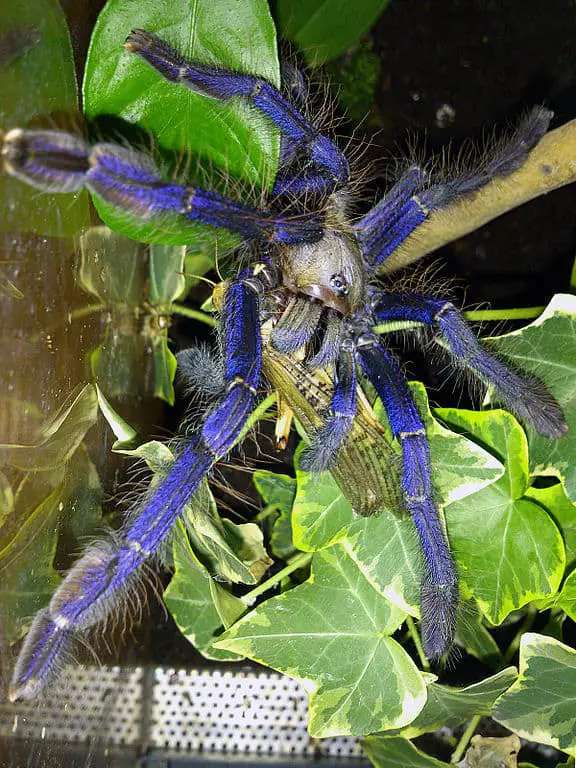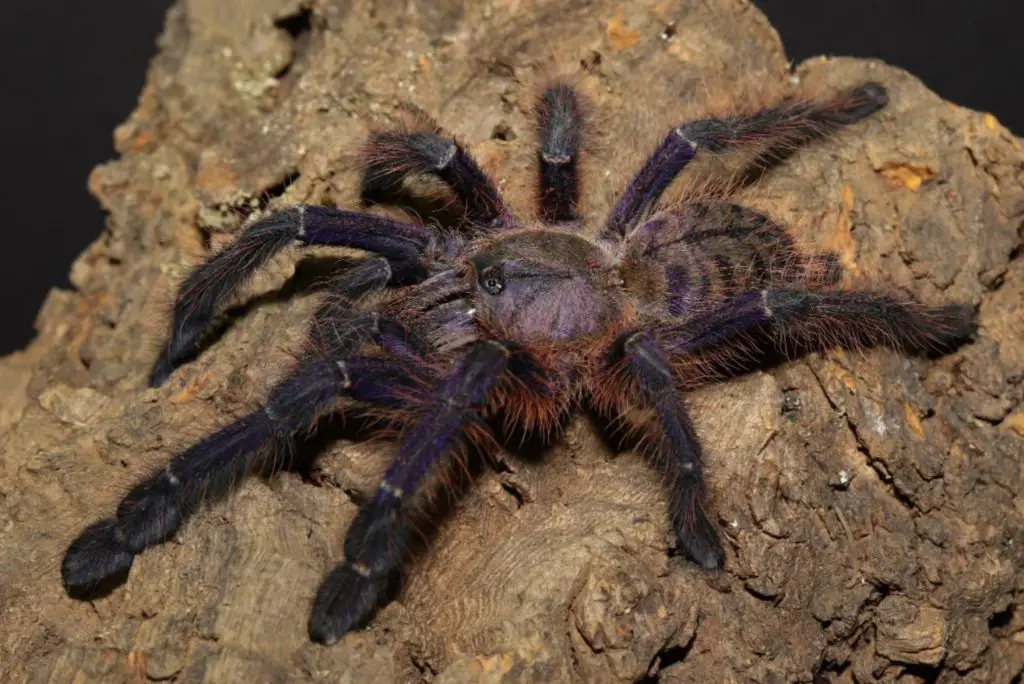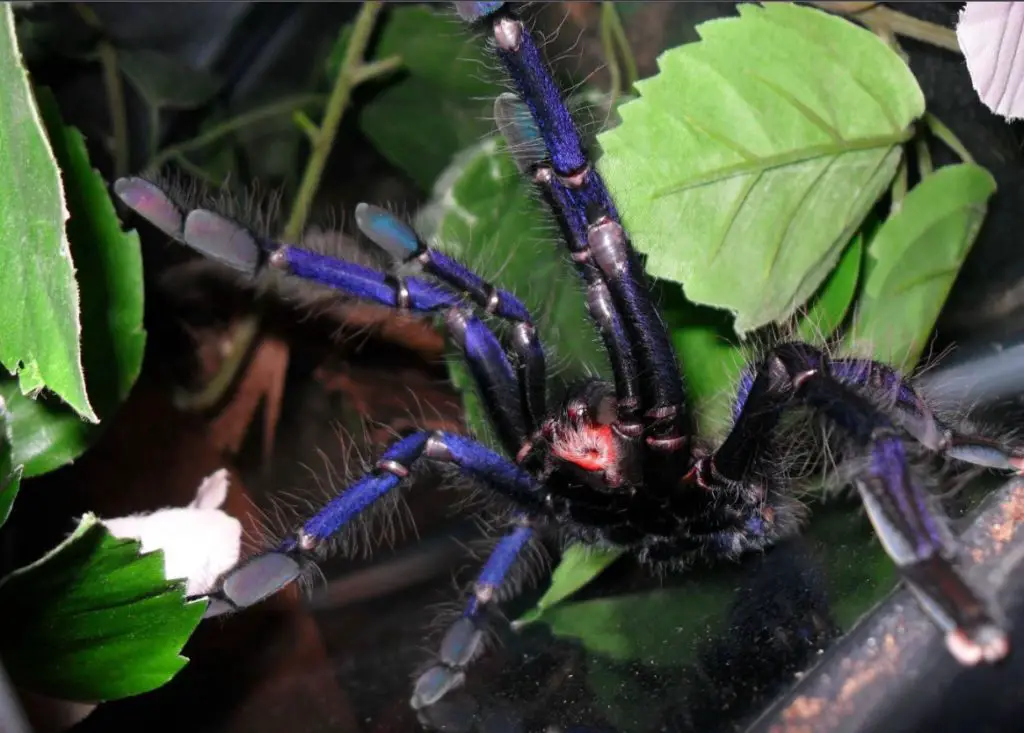The Singapore Blue Tarantula (Omothymus violaceopes) is an Old World arboreal species native to Singapore and Malaysia. They’re famed for their large size and striking blue color, and these features have made them incredibly popular among hobbyists.
However, despite the fact that they’re a pleasure to behold, they’re also quite defensive, fast, and have potent venom, which does not make them very suitable for beginners.
If you’re considering adding the Singapore Blue Tarantula to your collection, here is everything you need to know!

Singapore Blue Tarantula Care Sheet
| Species Name | Omothymus violaceopes |
| Family Name | Theraphosidae |
| Common Names | Singapore Blue Tarantula |
| Category | Old World |
| Type | Arboreal |
| Native Location | Singapore, Malaysia |
| Leg Span | 10 to 11 inches |
| Growth Speed | Fast |
| Urticating Hairs | No |
| Social | Solitary |
| Diet | Insects: primarily crickets and roaches |
| Temperature | 77 to 85 degrees °F |
| Humidity | 60 to 70% |
| Lifespan | Female: 14 years / Male: 5 years |
| Experience required | Advanced |
| Minimum tank size | 12x12x18 |
Singapore Blue Tarantula Overview
The Omothymus violaceopes, more commonly known as The Singapore Blue Tarantula, is a very large tarantula species that was first described in 1924 by H. C. Abraham. They’re native to Singapore and Malaysia, which makes them an Old World species. This means that they do not have urticating hairs, but do have quite a powerful venom. In addition, they’re incredibly quick on their feet and can move at very high speeds.
In the wild, they live in the trees in Singapore and Malaysia, where they feed on insects, mice, and even small birds.
They’re most well known for their striking blue color and incredible size.
Appearance & Variants

The Singapore Blue Tarantula is a very large species. Females can grow to a size of up to 11 inches. Males are typically quite a bit smaller, especially in the abdomen and carapace area.
They have intense blue legs, with a brown or golden carapace and reddish setae. Their abdomen is also blue, but often less bright than the legs.
As slings, they’re usually darker in color, and they don’t get the bright blue appearance that they’re so well known for until they’re older.
Males of this species are not only smaller, but they’re also less vibrant in color.
Sometimes, these spiders can appear to be more purple/indigo than blue, especially the females.
Price
The Singapore Blue Tarantula has a premium look with its bright colors, but they’re not all that expensive. 1″ to 1.5″ specimens can be found for sale online for $50.
However, females are typically quite a bit more expensive than males. If you buy a female sub-adult, you can expect to pay around $300, while male sub-adults cost around half of that.
Females are much more expensive because they have a much longer lifespan and brighter colors, making them much more desired.
Temperament & Behavior

Singapore Blue Tarantulas are not recommended for beginners. They have a defensive temperament and are easily startled. They don’t require much provocation to show a threat posture and will bite if you keep provoking them. You really should give them space when they feel threatened because they’re lightning-fast.
Since they’re an Old World species, getting a bite from this tarantula is not fun. They have potent venom that’s very painful to endure.
In addition, even though they’re an arboreal species, they’re not out in the open very much. They have a tendency to hide and since they’re so easily startled, they can interpret any kind of noise as a sign of danger, which will trigger them to hide. When they do come out, it tends to be at night.
On the whole, this spider is certainly beautiful to look at, but it’s definitely not a great choice for beginners. Its defensive nature, high speed, potent venom, and the fact that it tends to hide means that it’s better suited for experts.
Handling
I strongly recommend against handling this species at all. Even just rehousing them is already quite a pain because of how easy they are to startle. Handling them is not a good idea because if they do get startled while you’re handling them and they cannot run away they might bite.
On top of that, tarantulas do not really get anything out of you handling them. They’re not a cat or a dog that needs love and attention, they prefer to be left alone.
Caring for a Singapore Blue Tarantula
Tarantulas are the ultimate low-maintenance pets. They only need to be fed every 7 to 10 days, and they can even go months without eating if they absolutely have to.
However, while they are low-maintenance, there are some things you need to provide them with. Most important is an adequate enclosure with the right temperature and humidity, good substrate, water, food, and a hide.
Tank Setup
Singapore Blue slings can be kept in a vial with a twig so that they can climb, though they tend to create a web at the base of the twig and spend most of their time there.
However, as they get bigger, they will need a larger enclosure.
Adults of this species grow quite large, so they will need a decently sized enclosure. Give them a terrarium that’s a minimum of 12″x12″x18″, though it might need to be bigger if you have a particularly large specimen.
They’re arboreal spiders, so their enclosure needs to have more vertical than horizontal space in their enclosure.
Since they’re arboreal, they will need a piece of cork bark that’s hollow and big enough for them to use as a hide.
You can also place some other live or artificial plants in the enclosure to more closely mimic her natural habitat. This can increase the likelihood of her venturing out of her hide. Do note though that having live plants in the spider’s enclosure requires extra care.
Temperature & Humidity
When housing any animal it’s always a good idea to take note of the local temperature. That way, you can give them a home that has a climate that’s similar to their natural climate.
Singapore, where these animals come from, has a humid, warm climate. Typical temperatures range between 73 and 90 degrees Fahrenheit. Humidity is between 60 and 90%.
In captivity, they do well in temperatures that are between 77 and 85 degrees with the relative humidity being between 60 and 70%. Ventilation is also important but does make it more difficult to maintain high humidity levels.
To keep the humidity up, you can wet the substrate. Do keep in mind that you do not wet it too much though, it should be damp, but not swampy.
Substrate
Adult Singapore Blue Tarantulas need about 4 inches of substrate, while slings and juveniles need about 2 inches. Even though these spiders are arboreal, juveniles and slings do have a tendency to burrow sometimes.
Good material to use as the substrate is a mixture of coconut fiber, topsoil, peat moss, and vermiculite because it’s good at retaining humidity. If some of these things are difficult to find you can also leave one or two of these materials out and create a different kind of substrate, try to experiment to see what works best for you.
Watering
Adults Singapore Blue Tarantulas will drink from a water bowl if they need to. Slings that are too small to drink from a bowl will drink droplets. You can give them these droplets by dripping water down the side or by spraying the side of their enclosure.
Social
The Singapore Blue Tarantula is not a social spider and they’re not capable of communal living. They’re quite territorial and housing more than one of these tarantulas in the same enclosure has a very high chance of leading to cannibalism. If you want to keep your spider safe, house them solitarily.
Molting
The Singapore Blue is a very fast-growing species. As a result, they will molt frequently. You might notice that they will stop eating several days before a molt, this is normal. They do this because being a little bit slimmer makes it easier to shed their old exoskeleton.
During the molt, make sure that you do not disturb them. It’s a stressful time for them, and interacting with them during this time can result in a failed molt which can have bad consequences for the spider.
After the molt, make sure that you do not feed them for several days. They’re incapable of killing prey for a few days after the molt because they need time for their fangs to harden.
Diet & Feeding
The Singapore Blue Tarantula is a big spider with a big appetite. They’re ferocious eaters that have a very strong feeding response. They take down the insects you feed them with a lot of force which is interesting to see. However, they do typically wait until nighttime to feed.
Slings should be fed flightless fruit flies or cricket legs. You can feed the slings as much as you want, there’s not really any chance of overfeeding them. Just make sure that you remove uneaten food in a timely manner.
Once they reach juvenile size they can start eating live insects. Give them baby crickets and gradually increase the size of the prey as the spider gets larger. Avoid giving them anything that’s larger than their abdomen.
Adults have a big appetite and should be fed 5 large crickets or 2 dubia roaches every 7 to 10 days. The amount of food they need does depend on their size and whether they’re male or female, so try to figure out what works best for your spider.
Health & Lifespan
The Singapore Blue Tarantula has a lifespan that’s about average for tarantulas. Females live for up to 14 years, while males typically live for around 5 years.
While they can easily reach their maximum lifespan in captivity, there are a few things that you need to take care of in order to keep them healthy.
First, since this species needs high humidity it’s especially important that you remove molts and uneaten food as soon as possible to prevent bacterial growth and spider mites.
Secondly, make sure that you feed them only captive-bred insects. Wild-caught insects can be infected with parasites, which is something we should try to prevent giving to our eight-legged friends.
Singapore Blue Tarantula Facts
- It was originally named Lampropelma violaceopedes but the ICZN states that the names of species cannot be plural, so it was later renamed Omothymus violaceopes
- The Singapore Blue Tarantula used to be in the Lampropelma genus but was transferred in 2019 to the Omothymus genus
- They’re among the largest Old World tarantulas
Final words
The Singapore Blue is an extremely beautiful tarantula. Their colorful appearance and large size make them very popular among hobbyists, but you do have to know what you’re getting into. This species is fast, defensive, and has potent venom, making them not suitable for beginners.
If you’ve never owned a tarantula before, I highly recommend starting out with a more docile New World species, such as the Arizona Blonde or Antilles Pink toe. That way, you can get some experience under your belt first.
However, if you’ve got experience with Old World species, are captivated by this tarantula’s beautiful color, and think you’ve got what it takes to raise them properly then there’s no reason not to get one. They’ll make a beautiful addition to your collection.
- How Long Do American Eskimo Dogs Live? Important Factors and Care Tips - September 29, 2023
- Do American Bulldogs Need Grooming? Essential Tips and Care Guidelines - September 29, 2023
- Do Bengal Cats Enjoy Playing? Essential Tips for Keeping Them Active - September 29, 2023